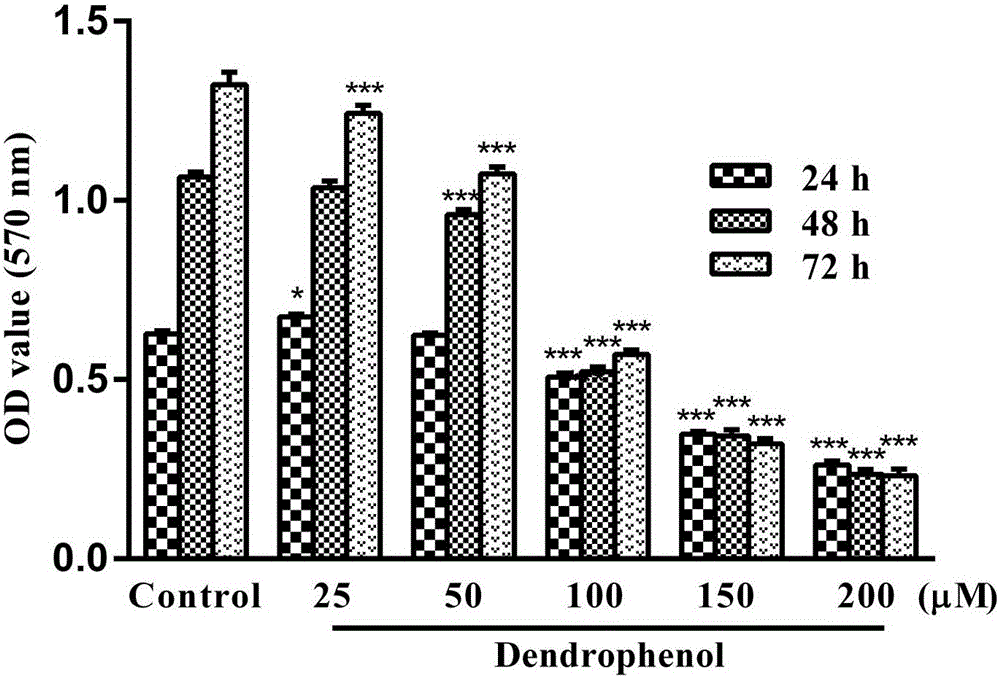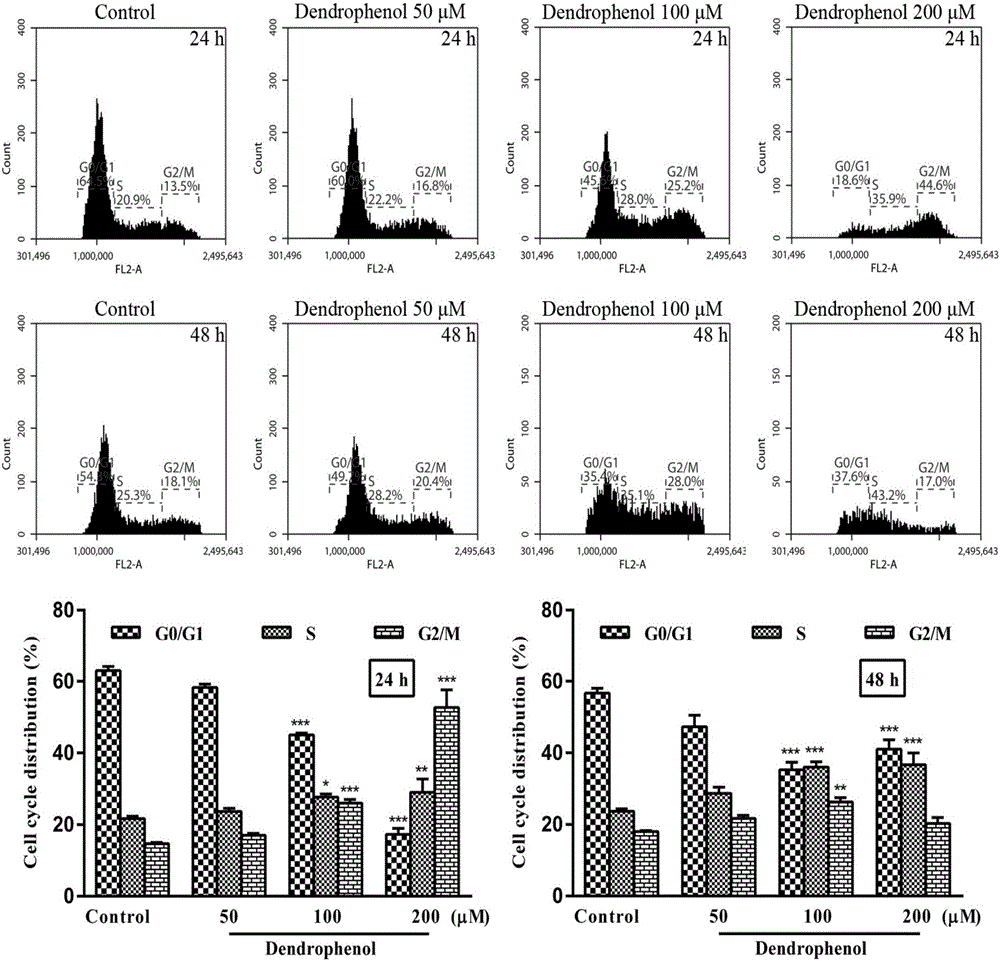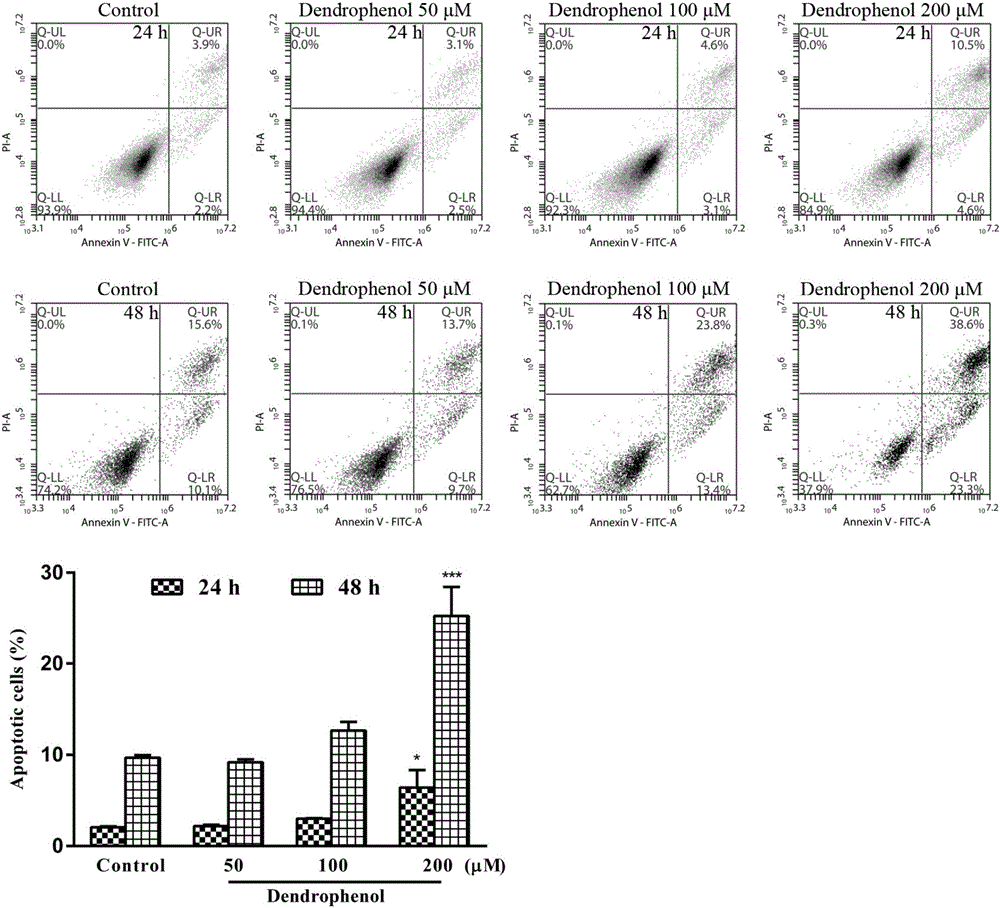Application of dendrophenol in preparing medicines for inhibiting proliferation of cervical carcinoma cells and for inducing autophagic apoptosis of cervical carcinoma cells
A technology for cervical cancer cells and cervix, applied in the field of dendrobium phenol, can solve problems such as cervical cancer that has not yet been seen, and achieve the effects of inducing cell cycle arrest and low production cost
- Summary
- Abstract
- Description
- Claims
- Application Information
AI Technical Summary
Problems solved by technology
Method used
Image
Examples
Embodiment 1
[0049] Example 1: Culture of Cells
[0050] 1. Recovery of cells
[0051] (1) Put sterilized pipette tips (10μL, 200μL, 1mL, 5mL) and centrifuge tubes, calf serum (WISENT INC), DMEM culture medium (WISENT INC), UV Sterilization is greater than 2h. Wear laboratory overalls and disposable rubber gloves during operation.
[0052] (2) Prepare hot water at 37°C in advance (38°C in winter), and take out the frozen human cervical cancer Hela-LC 3 cells (cryopreservation tube) from the ultra-low temperature refrigerator (gifted by Professor Wen Longping, School of Life Sciences, University of Science and Technology of China) immediately. Throw it into a water bath and stir it continuously with a glass rod to make it quickly pass through 0°C. After it is completely melted, spray it with alcohol and put it on the ultra-clean workbench.
[0053] (3) Both the serum and the culture medium were overheated, and the serum was added to DMEM at a volume ratio of 1 / 9 to make a cell culture me...
Embodiment 2
[0062] Embodiment 2: MTT detects cell proliferation
[0063] 1. Cell plating
[0064] (1) Prepare 96-well cell culture plates and hemocytometers, and sterilize the required consumables in advance.
[0065] (2) Microscopically examine Hela cells, and digest the cells to make a single cell suspension when they grow to a single layer.
[0066] (3) Count with a hemocytometer, and a bright dot observed under a microscope is a cell; record the number of cells in the eight counting areas as N 1 , N 2 ~N 8 , then the number of cells per milliliter in the suspension is calculated as N=[(N 1 +N 2 +…+N 8 ) / 8]×10 4 . 100 μL / well of Hela cells, 5×10 4 / mL of cells to plate.
[0067] (4) Take an appropriate amount of cell suspension and dilute it into a plating suspension with the required density, and the remaining suspension is used for subculture.
[0068] After plating is complete, mark the cell name and seeding time.
[0069] (5) Put it back into the CO2 incubator, and shak...
Embodiment 3
[0092] Example 3: Cell cycle detection
[0093] 1. Cell sample preparation
[0094] (1) Prepare centrifuge tube (2mL), PBS, trypsin (EDTA-free, 0.25%), and pre-cooled 70% ethanol solution in advance;
[0095] (2) Hela cells after the action of dendrobium, take out the six-well plate marked for 24h, and mark C (1, 2, 3), 50 (4, 5, 6), 100 (7 , 8, 9), 200μmol / L (10, 11, 12);
[0096] (3) Aspirate the cell culture solution in the well and place it in 12 centrifuge tubes (2mL) prepared in advance, and wash the cells once with PBS; , EDTA-free) digested cells;
[0097] (4) Discard the trypsin, add the collected cell culture solution back to the corresponding well to stop the digestion and blow it into a single cell suspension, and transfer it back to the corresponding centrifuge tube again;
[0098] (5) Centrifuge for 5min (1000rpm), discard the supernatant, resuspend in PBS, centrifuge again (1000rpm, 5min), discard the supernatant.
[0099] (6) Take pre-cooled 70% ethanol, r...
PUM
 Login to View More
Login to View More Abstract
Description
Claims
Application Information
 Login to View More
Login to View More - R&D
- Intellectual Property
- Life Sciences
- Materials
- Tech Scout
- Unparalleled Data Quality
- Higher Quality Content
- 60% Fewer Hallucinations
Browse by: Latest US Patents, China's latest patents, Technical Efficacy Thesaurus, Application Domain, Technology Topic, Popular Technical Reports.
© 2025 PatSnap. All rights reserved.Legal|Privacy policy|Modern Slavery Act Transparency Statement|Sitemap|About US| Contact US: help@patsnap.com



